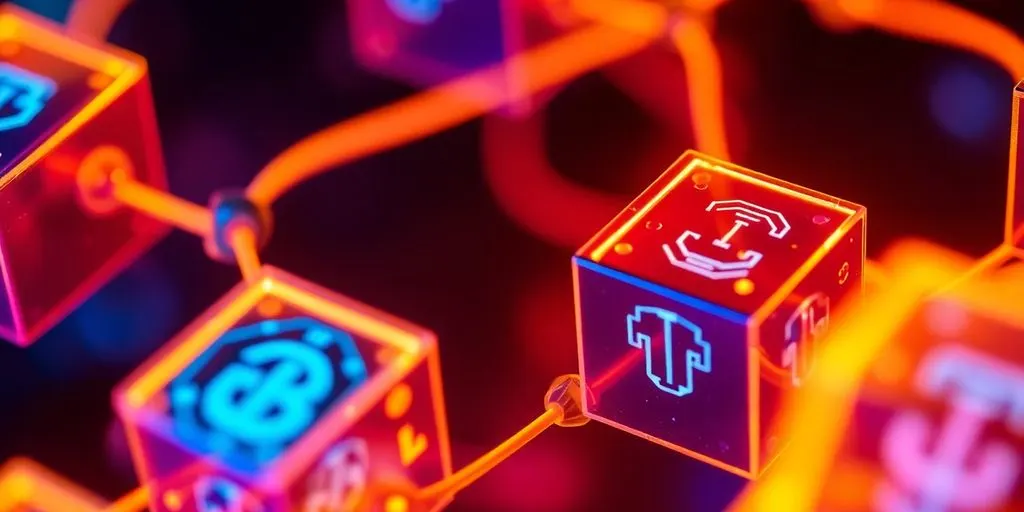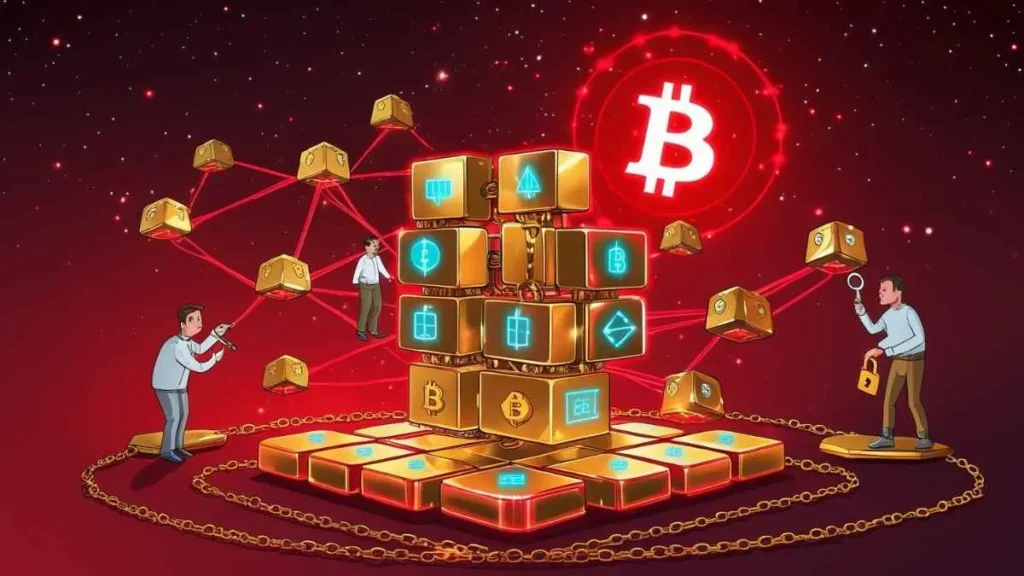Blockchain might sound complicated, but at its core, it’s a way to securely and transparently track information. Imagine a digital notebook everyone can see, but no one can erase or change what’s written. This technology is revolutionizing how we think about data and transactions, making processes more efficient and trustworthy. Let’s break it down into simple terms so you can grasp what blockchain really is and how it works.
- Blockchain is a digital ledger that records information across a network of computers.
- Data is stored in linked blocks, making it hard to alter any information.
- Decentralization means no single person controls the blockchain, which enhances security and trust.
- Once data is entered into the blockchain, it cannot be changed, ensuring its immutability.
- Blockchain technology has various applications, including cryptocurrencies and supply chain management.
Understanding Blockchain Technology
Definition of Blockchain
Okay, so what is blockchain? It’s a digital record book, but instead of being kept in one place, it’s spread across many computers. Think of it as a shared, unchangeable ledger. This ledger records transactions in a way that’s super secure and transparent. It’s not just for cryptocurrencies; it can be used for all data.
How Blockchain Works
Imagine a chain made of blocks, where each block holds some information. When a new transaction happens, it gets added to a block. That block then gets linked to the previous block in the chain using some fancy math called cryptography. Because each block is linked to the one before it, it’s really hard to mess with the data. If someone tries to change one block, it would mess up all the blocks after it. This makes the blockchain very secure.
Key Characteristics of Blockchain
Blockchain has a few things that make it special:
- Decentralization: No single person or company controls the blockchain. It’s distributed among many users.
- Immutability: Once data is added to the blockchain, it’s really hard to change or delete it.
- Transparency: Everyone on the network can usually see the transactions that are happening.
Blockchain’s design inherently promotes trust and security. Distributing the ledger across multiple participants eliminates the single point of failure that exists in traditional centralized systems. Combined with cryptographic techniques, this distribution ensures that all network members keep the data tamper-proof and verifiable.
The Structure of a Blockchain

Blocks and Chains
Okay, so you’ve heard about blockchains, but what exactly are they made of? Think of it like a digital Lego set. The fundamental building block is, well, a block. Each block holds a bunch of transaction data. These blocks are then chained together in a specific order, creating a chain of blocks – hence the name, blockchain. It’s not just a random pile; the order matters, and each block is linked to the one before it.
Data Storage in Blockchain
So, what kind of stuff gets stored in these blocks? It really depends on the blockchain. For Bitcoin, it’s mostly transaction details – who sent what to whom. However, other blockchains can store all sorts of data, like medical records, supply chain information, or voting records. The cool thing is that once the data is in a block, it’s hard to change it. This is because of how the blocks are linked together using something called a hash. The blockchain technology’s layers are designed to enhance security and efficiency.
Hashing and Security
Okay, let’s talk about hashing. Each block has a unique fingerprint called a hash. This hash is like a super-strong password that identifies the block. But here’s the clever part: each block’s hash also includes the hash of the previous block. This creates a chain reaction. If someone tries to mess with the data in one block, it changes that block’s hash, which then changes the hash of all the blocks that come after it. This makes it super obvious that something has been tampered with. It’s like a digital alarm system for your data.
Imagine a tower of blocks. Each block contains information and a unique identifier (the hash). If you try to change the information in one block, its identifier changes, and because each block is linked to the previous one, the whole tower becomes unstable. This makes it incredibly difficult to tamper with the data stored in the blockchain.
Here’s a simple way to think about it:
- Each block contains data.
- Each block has a unique hash.
- Each block’s hash includes the previous block’s hash.
- This creates a secure, tamper-proof chain.
Decentralization in Blockchain

What is Decentralization?
Okay, so what’s the big deal with decentralization? Basically, instead of one central authority calling all the shots, the power is spread out. Think of it like this: instead of one giant bank controlling all the money, many smaller banks each hold a piece. This distribution of control is what decentralization is all about. It’s a core concept in blockchain, and it changes everything.
Benefits of Decentralization
Why go decentralized? Well, a few reasons:
- No single point of failure: If one computer goes down, the whole system doesn’t crash. There are plenty of other computers to keep things running. This is a huge advantage over traditional systems.
- Increased security: It’s way harder for hackers to attack a decentralized network because they’d have to attack many computers simultaneously, instead of just one. This makes blockchain decentralization much more secure.
- Greater transparency: Because everyone has a copy of the blockchain, it’s easier to see what’s going on. This can help build trust and prevent fraud.
Decentralization reduces the risk of censorship and manipulation. No single entity can control the network or block transactions, making it a more democratic and open system.
Examples of Decentralized Systems
So, where do we see decentralization in action? Besides blockchain, there are other examples:
- The Internet: No one company or government controls the entire Internet. It’s a network of networks, so it’s so resilient.
- Open-source software: Anyone can contribute to open-source projects, and the code is freely available. This means no one company owns the software.
- Peer-to-peer file sharing: Services like BitTorrent allow users to share files directly, without a central server. This is a classic example of a decentralized system.
Immutability and Transparency

What is Immutability?
Immutability, in the context of blockchain, means that once data is recorded on the blockchain, it cannot be altered or deleted. Think of it like writing in ink versus pencil; once it’s in ink, it’s there permanently. This is achieved through cryptographic hashing, where each block of data contains a hash of the previous block, creating a chain of linked blocks`. If someone tries to change data in a previous block, the hash changes, and all subsequent blocks would also need to be altered, which is computationally infeasible due to the consensus mechanisms in place. This feature is what makes blockchain a reliable immutable ledger for various applications.
Importance of Transparency
Transparency in blockchain doesn’t necessarily mean that all data is public, but that transaction data is visible and auditable. In many blockchains, like Bitcoin, every transaction is recorded on a public ledger, and anyone can view the details of these transactions. However, the identities of the parties involved are often pseudonymous, meaning they are represented by cryptographic addresses rather than real-world identities. This level of transparency allows for greater accountability and trust, as anyone can verify the validity of transactions and the state of the blockchain. You can use blockchain explorers to see transactions occurring live.
How Immutability Enhances Security
Immutability is a cornerstone of blockchain security. Because data cannot be altered, it’s extremely difficult for malicious actors to tamper with the blockchain. This is especially important in applications where data integrity is critical, such as supply chain management or voting systems. The combination of immutability and transparency creates a system where fraud and corruption are much more difficult to perpetrate. Each additional block strengthens the verification of the previous block and hence the entire blockchain. Rendering the blockchain tamper-evident, delivering the key strength of immutability. Removing the possibility of tampering by a malicious actor, and builds a ledger of transactions you and other network members can trust.
Imagine a traditional database where a single administrator has the power to change records at will. Now, picture a blockchain where every change is recorded and verified by a network of participants, making it virtually impossible to alter past records without detection. This fundamental difference is what makes blockchain so secure and trustworthy.
Here’s a simple breakdown of how immutability contributes to security:
- Data Integrity: Ensures that data remains unchanged and accurate over time.
- Tamper-Proof: Makes it extremely difficult for unauthorized parties to alter data.
- Auditability: Allows for easy verification of transactions and data.
Applications of Blockchain Technology
Blockchain isn’t just for Bitcoin anymore. It’s finding its way into all sorts of industries, and honestly, it’s pretty interesting to see where it’s popping up. People are always figuring out new uses, and it feels like we’re just scratching the surface of what’s possible. Let’s take a look at some of the main areas where blockchain is making a difference.
Cryptocurrencies
Okay, yeah, we have to start here. Cryptocurrencies, distributed ledger like Bitcoin, were the first big blockchain application, and they’re still a major one. The whole idea of decentralized, secure digital money got many people interested in blockchain in the first place. It’s more than just digital cash; it’s about taking control of your finances and cutting out the middleman.
Smart Contracts
Smart contracts are where things get really interesting. These are basically self-executing contracts written into the blockchain. Imagine a contract automatically paying out when certain conditions are met – no lawyers, no paperwork, just code. It’s a way to automate agreements and make sure everyone holds up their end of the deal. Think of it like this:
- Automated Escrow: Funds are held until a service is completed.
- Supply Chain Tracking: Payments are released when goods reach their destination.
- Voting Systems: Results are automatically tallied and verified.
Supply Chain Management
Ever wonder where your food comes from? Blockchain can help with that. Companies can use blockchain to improve supply chain management by tracking products from origin to store. This means better transparency, faster recall times if there’s a problem, and more confidence that what you’re buying is the real deal.
It’s about knowing exactly where something came from, how it was handled, and who touched it. This can be a game-changer for industries like food, pharmaceuticals, and luxury goods, where authenticity and safety are key.
Benefits of Using Blockchain
Blockchain tech is getting a lot of buzz, and for good reason. It’s not just about cryptocurrencies; it’s about changing how we do things across many industries. Let’s break down some of the main advantages.
Cost Reduction
One of the biggest draws of blockchain is its potential to cut costs. Think about it: Traditionally, you might need a bank to verify a transaction or a lawyer to oversee a contract. Blockchain can automate a lot of that, reducing the need for those middlemen. This is especially true in areas like supply chain management, where tracking goods can involve a ton of paperwork and third-party verification. Using a blockchain can streamline the process and save money on fees and administrative overhead.
Increased Security
Security is a major selling point for blockchain. Because data is distributed across a network and secured with cryptography, it’s incredibly difficult for hackers to tamper with it. Imagine trying to change a record on a blockchain; you’d have to alter it on thousands of computers simultaneously, which is practically impossible. This makes blockchain a great option for storing sensitive information, like medical records or financial data. Plus, the decentralized nature of blockchain means there’s no single point of failure, making it more resilient to attacks.
Enhanced Trust
Trust is a big deal in any transaction, whether it’s buying a house or sending money to a friend. Blockchain can help build trust by providing a transparent and immutable record of transactions. Everyone on the network can see what’s happening, and once a transaction is recorded, it can’t be changed. This can be especially useful when trust is lacking, such as in international trade or in industries with a history of fraud. For example, using blockchain for smart contracts can automate agreements and ensure everyone fulfills their obligations.
Blockchain’s ability to create a shared, verifiable record can transform how businesses and individuals interact, leading to more efficient and trustworthy relationships.
Here’s a quick look at how blockchain stacks up against traditional systems:
| Feature | Blockchain | Traditional Systems |
| Security | High, due to cryptography and decentralization | Vulnerable to single points of failure |
| Cost | Lower, due to reduced intermediaries | Higher, due to third-party involvement |
| Transparency | High, all transactions are visible | Limited, often opaque |
| Trust | Enhanced, due to immutability | Relies on intermediaries |
Challenges Facing Blockchain Adoption

Scalability Issues
Okay, so blockchain is cool, but let’s be real – it’s not perfect. One of the biggest headaches is scalability. Think of it like this: imagine a small coffee shop that suddenly becomes super popular. The line gets long, orders take forever, and everyone’s frustrated. That’s what happens with blockchain when too many people try to use it at once. The system slows down, and transaction fees can skyrocket.
- Limited Transactions Per Second (TPS): Blockchains like Bitcoin can only handle a few transactions per second, way less than traditional systems like Visa.
- Network Congestion: High traffic leads to delays and increased costs.
- Complex Solutions: Efforts to improve scalability, like sharding or layer-2 solutions, add complexity.
It’s like trying to build a highway with only one lane. You can add more lanes (solutions), but it takes time, money, and can create even more problems.
Regulatory Concerns
Figuring out the legal stuff around blockchain is like trying to assemble furniture without instructions. Different countries have different rules, and sometimes, there aren’t no rules! This makes it hard for businesses to know what they can and can’t do, creating uncertainty for investors. The lack of clear blockchain regulation is a major hurdle.
- Varying Jurisdictions: Laws differ significantly from country to country.
- Uncertainty: Lack of clear legal frameworks hinders adoption.
- Compliance Costs: Businesses face high costs to ensure they meet regulatory requirements.
Energy Consumption
Let’s talk about the elephant in the room: energy. Some blockchains, especially those that use “proof-of-work” (like Bitcoin), use a ton of electricity. It’s like leaving all the lights on in your house 24/7. This is bad for the environment and raises questions about the long-term sustainability of these technologies. The high energy consumption is a major concern for environmentalists and businesses alike.
- Proof-of-Work (PoW): This consensus mechanism requires significant computational power.
- Environmental Impact: High energy use contributes to carbon emissions.
- Alternative Solutions: Efforts are underway to develop more energy-efficient consensus mechanisms, like proof-of-stake (PoS).
Wrapping It Up
So, there you have it. Blockchain is basically a way to keep track of information in a secure and transparent manner. It’s like a digital notebook everyone can see but no one can change. This makes it useful for money transactions, contracts, and even tracking goods. While it started with Bitcoin, its uses are popping up everywhere now. It’s not just for techies anymore; it’s becoming a part of everyday life. As more people learn about it, who knows what else we might see it used for in the future?
Blockchain is like a digital notebook that is shared across many computers. It keeps a record of information so everyone can see it, and once something is written down, it cannot be changed.
Blockchain works by putting information into groups called blocks. Each block is connected to the previous one, forming a chain. This makes it hard for anyone to change the information without everyone noticing.
Blockchain is secure because it uses special codes, called hashes, to link blocks together. If someone tries to change a block, the code will change, and the other computers will reject it.
Decentralization means that no single person or group controls the blockchain. Instead, control is shared among all users, which helps prevent fraud and mistakes.
Blockchain is used for many things, like cryptocurrencies (like Bitcoin), smart contracts that automatically execute when conditions are met, and tracking products in supply chains.
Using blockchain can save money, make transactions more secure, and build trust between people because everyone can see the same information.






